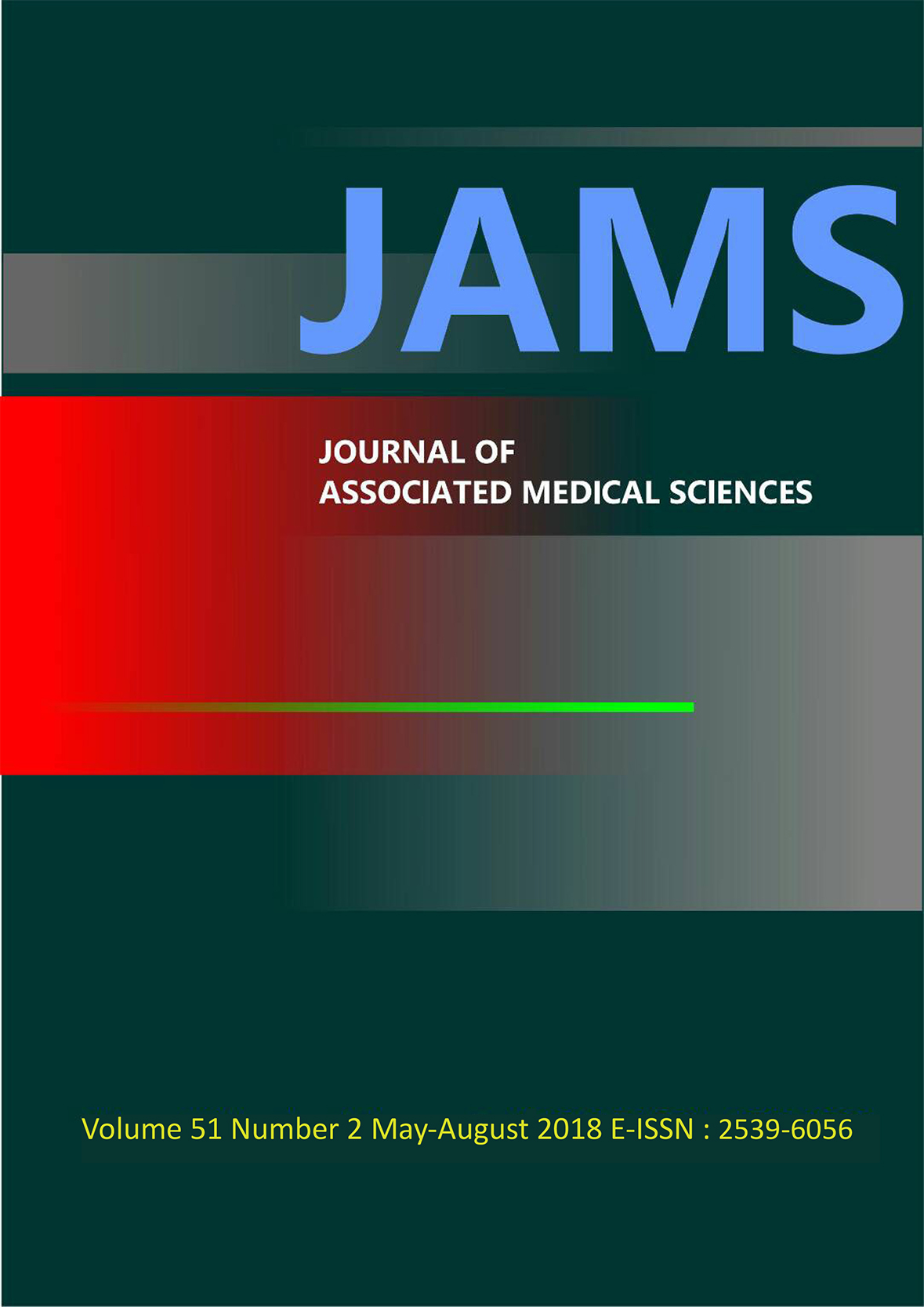Plan evaluation of intensity modulated radiation therapy and volumetric modulated arc therapy in bilateral breast irradiation with 3-isocenter technique
Main Article Content
Abstract
Background: Bilateral breast irradiation needs a sophisticated treatment planning due to large treated volume and the concern regarding low dose to the volume of irradiated normal lungs and heart.
Objectives: Aim of this study was to compare the dosimetric parameter between intensity modulated radiation therapy (IMRT) and volumetric modulated arc therapy (VMAT) plan with 3-isocenter technique for bilateral breast irradiation.
Materials and methods: Retrospective cases from 5 bilateral breast cancer were reviewed. Eclipse treatment planning version 11.0.31 was used for IMRT and VMAT optimization. The prescribed dose was 50 Gy in 25 fractions. Three isocenters were used to setup position; left, middle and right of PTV volume in lateral direction changes while the longitudinal and vertical directions were fixed. PTV of D95%, conformity index (Vprescribed/VPTV) and dose homogeneity (D5%-D95%), mean lung dose (MLD) and volume receiving 20 Gy (V20Gy), heart volume received dose 25 Gy (V25Gy), maximum dose of left anterior descending coronary artery (LAD), and the number of MUs per fraction were compared for both techniques.
Results: Mean D95% of PTV was 48.7±0.2 Gy for IMRT and 48.7±0.8 Gy for VMAT. Mean CI for IMRT and VMAT techniques were 0.97±0.0 and 0.98±0.0, respectively. IMRT plans showed significantly better for homogeneity of dose distribution in PTV volume than VMAT with the values of 5.6±0.7 Gy for IMRT and 7.6±1.1 Gy for VMAT. MLD was not significantly different between the plans 16.2±0.6 Gy (IMRT) and 16.6±0.9 Gy (VMAT). However, V20Gy of lung showed significant difference for IMRT (25.8±4.8%) and VMAT (31.6±2.4%). The volume of heart received dose 25 Gy was 8.3±3.3% (IMRT) and 12.2±5.0% (VMAT). Two tails student t-test exhibited no significant differences between IMRT and VMAT in almost all parameters. Ratio of MUIMRT to MUVMAT was 3.0 which was the crucial part of using VMAT plan for treatment.
Conclusion: The 3-isocenter technique of VMAT plan for bilateral breast irradiation shows comparable plan quality to IMRT with shorter treatment delivery time. It demonstrates feasible to apply in clinical used due to short treatment time and easy setup.
Article Details

This work is licensed under a Creative Commons Attribution-NonCommercial-NoDerivatives 4.0 International License.
Personal views expressed by the contributors in their articles are not necessarily those of the Journal of Associated Medical Sciences, Faculty of Associated Medical Sciences, Chiang Mai University.
References
[2] Fogliata A, Clivio A, Nicolini G, Vanetti E, Cozzi L: Intensity modulations with photons for benign intracranial tumor. A planning comparison of volumetric single arc, helical arc and fixed gantry tecniques. Radiother Oncol 2008, 89: 254-62.
[3] Kjaer-Krisoffersen F, Ohlhues L, Medin J, Korreman S: RapidArc volumetric modulated therapy planning for prostate cancer patients. Acta Oncol 2009, 48: 227-32.
[4] Singla R, King S, Albuquerque K, Creech S, Dogan N: Simultaneous integrated boost intensity modulated radiation therapy (SIB-IMRT) in the treatment of early stage left side breast carcinoma. Med Dosim 2006, 31: 190-6.
[5] Qiu JJ, Chang Z, Wu QJ, Yoo S, Horton J, Yin FF. Impact of volumetric modulated arc therapy technique on treatment with partial breast irradiation. Int J Radiat Oncol Biol Phys 2010, 78: 288–96.
[6] Popescu CC, Olivotto IA, Beckham WA, Ansbacher W, Zavgorodni S, Shaffer R, et al. Volumetric modulated arc therapy improves dosimetry and reduces treatment time compared to conventional intensity-modulated radiotherapy for locoregional radiotherapy of left-sided breast cancer and internal mammary nodes. Int J Radiat Oncol Biol Phys 2010, 76: 287–95
[7] Ivessa M. Dijkema, Pieter Hofman, Cornelis P.J. Raaijmakers: Loco-regional conformal radiotherapy of the breast: delineation of the regional lymph node clinical target volumes in treatment position. Radiother Oncol 2004, 71: 287-95.
[8] Rana S: Intensity modulated radiation therapy versus volumetric modulated arc therapy. J Med Radiat Sci 2013, 60: 3: 81-83.
[9] Nicolini G, Clivio A, Fogliata A, Vanetti E, Cozzi L: Simultaneous integrated boost radiotherapy for bilateral breast: a treatment planning and dosimetric comparison for volumetric modulated arc and fixed field intensity modulated therapy. Radiation Oncol 2009, 4: 27: 1-12.
[10] M Teoh, CH Clark, K Wood, S Whitaker, A Nisbet: Volumetric modulated arc therapy: a review of current literature and clinical use in practice. Br J Radiol. 2011, 84: 1007: 967-96.


